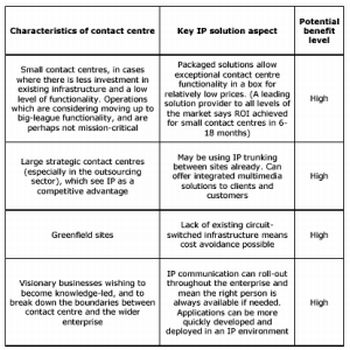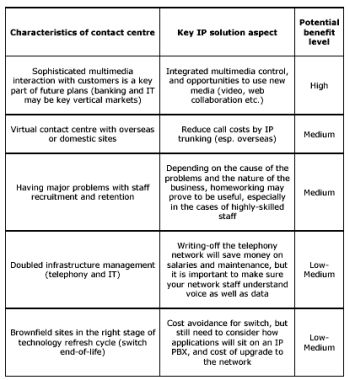 When IP telephony was first taken onto the market, there were (justifiable) concerns about its reliability and security. Today there is no reason why, in a well-managed and designed QoS network, IP telephony should not have the same levels of resilience as circuit-switched telephony, yet the same concerns are still aired. Larger UK contact centres are most concerned about both reliability and security, with 65 per cent citing fears about reliability as having a considerable or major effect on their decisions.
When IP telephony was first taken onto the market, there were (justifiable) concerns about its reliability and security. Today there is no reason why, in a well-managed and designed QoS network, IP telephony should not have the same levels of resilience as circuit-switched telephony, yet the same concerns are still aired. Larger UK contact centres are most concerned about both reliability and security, with 65 per cent citing fears about reliability as having a considerable or major effect on their decisions.
The Reality of IP Contact Centres in the UK is a study based upon 114 telephone interviews with senior UK contact centre influencers and decision-makers in December 2002 and January 2003, as well as in-depth product interviews with leading IP solution providers.
 This report is aimed at looking at exactly what is going on in the IP contact centre world, through case studies, expert opinion, objective vendor profiles, and most of all, a detailed and thorough understanding about what leading contact centres are thinking and doing about IP. Some key findings follow.
This report is aimed at looking at exactly what is going on in the IP contact centre world, through case studies, expert opinion, objective vendor profiles, and most of all, a detailed and thorough understanding about what leading contact centres are thinking and doing about IP. Some key findings follow.
Advantages of implementing IP contact centre solutions
Some of the key benefits that IP-enabled contact centres can expect are:
Enables homeworking and remote office model
Promotes the successful take-up and management of multimedia customer
interactions
Use of common protocol (IP) allows rapid development of new
functionality
More affordable functionality available to smaller contact centres
Reduces cost of maintaining two networks
Flexibility of adding and changing agents
Reduction in call charges between sites via IP trunking
Reduced staff attrition
Boundaries between contact centre and the wider business break down
IP infrastructure may be cheaper to upgrade than circuit-switched platform
Reduced call costs in a hosted environment
The main influence upon actual decision-making was the existence of convincing return-on-investment figures. On a greenfield site, ROI is easier to prove: putting only one network in place, avoidance of switch purchase cost, and lower management costs are immediately available.
In an existing site, ROI can be more difficult to prove, and it can require a strategic decision to take place before IP will be installed, such as the desire to use homeworkers or remote sites, gain a single view of the customer, or improve flexibility going forward.
The ability to develop multimedia channels more fully also pays a significant role in decision-making, and comes a clear second to proof of ROI. Other factors, such as homeworking, the need to replace infrastructure and IP implementations from competitors play less of a role generally, although they can be critical on a caseby-case basis.
Inhibitors of IP implementations
There is a reluctance amongst many contact centre decision-makers to implement IP, for a number of strongly-felt reasons (ranked in order):
Reliability
Expense
Don’t know enough about IP
Security
Lack of advantages over existing systems
Wasted existing investment
Internal politics
Upheaval
Risk of early adoption
Little multimedia interaction planned
The expense of the implementation can be an inhibitor, but for greenfield sites and operations looking to replace their switch, the cost of IP implementations may compare favourably to traditional implementations. Cost is believed by respondents from the largest contact centres to be less of a future issue.
 There is concern at all levels that IP may not bring any advantages to the contact centre. In a way, this has some truth to it: an IP infrastructure may save some money through IP trunking and reducing management overheads, but its main advantage is as an enabler to provide superior multimedia service, greater flexibility of workforce, improved functionality which is easy to deploy and a fundamental asset the opportunity to future-proof the contact centre as far as it can be.
There is concern at all levels that IP may not bring any advantages to the contact centre. In a way, this has some truth to it: an IP infrastructure may save some money through IP trunking and reducing management overheads, but its main advantage is as an enabler to provide superior multimedia service, greater flexibility of workforce, improved functionality which is easy to deploy and a fundamental asset the opportunity to future-proof the contact centre as far as it can be.
Present and future take-up of IP contact centre solutions
Survey respondents were reasonably evenly divided amongst those which had or were definitely implementing IP, those which were researching the option, and those which had no foreseeable plans to implement IP .
Implemented – 14%
Pilot scheme – 10%
Will implement in next two years – 15%
Formally researching – 14%
Informally researching – 15%
Not seriously considered – 28%
Will not implement in next two years – 4%
Initial interest in IP contact centre solutions is likely to be shown by operational management, often the contact centres IT manager. However, the ultimate decision is likely to be made at the very highest levels of a business, at senior executive level. This is because IP is a strategic decision, aimed at enabling the contact centre to perform more effectively in the longer term, rather than being an example of a cost-saving technology.
Even amongst those respondents which have not yet made any final decision on IP, more than two-thirds expect that they will have implemented IP by 2005.
In the longer term, most respondents and suppliers (even those which are not yet offering IP solutions) feel that IP-based contact centres are likely to be the norm. However, due to the potential cost of upgrading, a widespread movement towards IP is not likely in the short-term, but contact centres with the following characteristics are more likely to see benefits from IP sooner than most.
Actual implementations of IP contact centre solutions are relatively few and farbetween. However, the technology is available today to offer real options for operations which have reached the PBX end-of-life stage, wish to develop virtual contact centre functionality, offer sophisticated multimedia interactions to customer, or break down the boundaries between business and the contact centre.
Steve Morrell
2003-06-11
To know more about this study click here
Em Foco – Opinião

